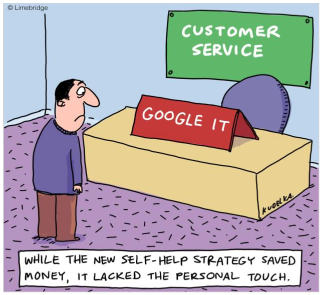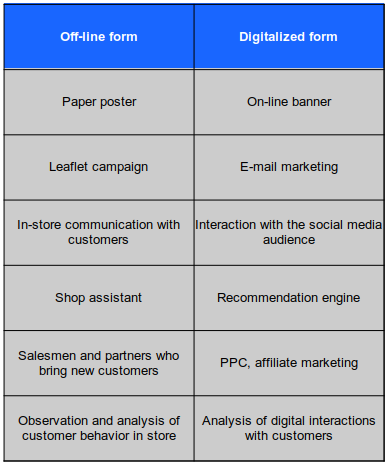Welcome! Our “Unlocking AI potential in e-commerce and online business” series aims to provide basic guidance on applying AI (Artificial Intelligence) in businesses which use the internet as a primary source for delivering value to their customers.
Today we will discuss content personalization and how AI could be used to make it better. Hope you will enjoy your reading!
The customer is the boss
- Cost optimization and need prediction
- Personalized experience
- Privacy and security enhancement
These three themes emerge as priorities for the leaders, according to this article, published by Bain & Company. For instance, Adidas views demand prediction as the third most important area to focus on.
Are you new to AI and Machine Learning? If so, we recommend the first article in our “Unlocking AI potential in e-commerce and online business” dealing with basic concepts.
The portion of transactions which are done using new technologies is increasing steadily.
- A PwC study says the percentage of respondents who buy something online weekly or more frequently rose five percentage points year-over-year, to 31%.
The battle for customers is shifting towards the digital world. A new generation is coming, priorities are changing. This could mean serious issues for some businesses. For instance, a recent Bloomberg article describes the troubles of the retail store Forever 21 Inc.
In response to these changes, PwC has introduced a new metric – Return of Experience (ROX).
- The purpose of ROX is to measure return of investment in the parts of the company directly related to how people interact with the brand.
The personal touch
The downside of the shift towards an online environment is that customers became viewed as a mere number in statistics. If you can’t measure it, you can’t improve it. Nevertheless, the biggest value yields full integration of the new technology into the company culture.

Besides the online interface, customers are often in touch with customer support, call center and other parts of the business, which still rely on the human factor, and therefore employee experience.
- A PwC study from last year shows that 32% of all customers would stop doing business with a brand they loved after just one bad experience.
Artificial intelligence and human interaction
Except for customer support, the numbers are quite clear – the interpersonal interaction is being slowly eliminated and not just in the online world.
- This February, CBC released an article stating that almost 46 per cent of respondents aged 19 to 34 said they favor a machine over a cashier at the checkout.
This table shows the offline activities and their digital counterpart:

Artificial Intelligence can be used to improve each of these activities. In one of our previous articles, we focused on the black-box problem and what is behind the scenes in AI algorithms. Let’s have a closer look at probably the most frequently used case for AI in e-commerce – content personalization.
Using AI to create personalized content
We have already mentioned how to select the right data for machine learning in one of our previous articles.
Artificial Intelligence can only be as good as the training data.
That’s why we should choose the algorithm most suitable for the given data availability and quality.
Expert system
In case we are not sure about the data quantity and quality, an expert system is probably the best option we have.
Expert systems have been around for nearly 50 years. We can think of them as hard coded decision trees. Tree rules are based on expert knowledge and statistical evidence.
In e-commerce, we can use such rules as:
- if the weather is cold, recommend a coat
- if a customer already bought something in the past, recommend something which he/she has not yet bought
- if a customer browses the “shoes” category, recommend something from the “belts” category
There is beauty in simplicity. Even a simple expert system built on domain knowledge can achieve much better results than chosen content.
After some time, when a larger amount of data is available, we can enhance the model with rules based on data analysis and statistics which is the first step towards machine learning.
Machine Learning
In general, there are two ways of using AI for recommendations:
- Computing similarity between customers based on their transactions
- Computing similarity between customer features, product features or both
A common way to represent this kind of similarity is associative modeling using a similarity matrix.
- A similarity matrix is a square symmetric matrix where index
[i, j]represents the similarity between itemsiandj.
At the start, the matrix is filled with zeros, ones or some other value. The matrix is usually updated with every purchase. It can be updated on a daily or weekly basis as well.

The advantage of this approach is that it’s easy to implement forgetting.
- Forgetting, in the machine learning context, is a process of gradual elimination of the effect of historical data.
When using a similarity matrix, we can simply multiply the matrix with some number below one or normalize the matrix into a given interval once per day or week.
A similarity matrix can also be used to cluster customers or products. Once we have the similarity matrix, we can extract clusters using similarity values and hierarchical clustering.
Hybrid models
There are multiple ways to make a tool for content personalization. The “no free lunch” theorem almost always applies. Each approach has its pros and cons:
Hard coded rules
pros:
- understandability
- computation time
- data requirements
cons:
- preparation time (all rules need to be created manually)
- rigidity (the model does not adapt to changing conditions)
- maintenance (must be adjusted manually)
Machine learning
pros:
- almost no maintenance needed because of the adaptability
- performance increases with the amount of data
cons:
- computation time
- data requirements
- slightly worse understandability
That’s why we often combine several types of models to get the best out of each of them. If we have enough quality data for a particular customer segment, we use machine learning, otherwise we use a rule-based system.
Other roles of AI in content personalization
Better data, better results. That’s why AI is often used to prepare them:
- We can use natural language processing to extract important features from text such as product description or customer communication.
- Image recognition can be used to measure the similarity between products based on their pictures.
All this information can be used to improve the model accuracy, and better accuracy means better customer experience.
One caveat of artificial intelligence is overfitting and convergence towards a local maximum. Customers respond more frequently to content we serve to them which means the same content will get a better chance to be recommended again in the future. Even if it seems logical on first sight, it can lead to the isolation of some content. Such content may never be recommended at all which means we will never know whether it is a better option. To prevent this from happening, we should always generate some portion of the content at random.
How to successfully execute AI-related projects? You can find a few tips in this article in our “Unlocking AI potential in e-commerce and online business” series!
What next?
Would you like to see some practical examples how to approach content personalization using AI and Data Science? Then check out our Python template which we have prepared for you! It is available on GitLab, including dummy data for testing.
About the author
My name is Ondřej Kopička and I help companies automate data analysis.
Does the volume of your data exceed the capacity of your analysts? Then we should talk.
Connect with me on LinkedIn: https://www.linkedin.com/in/ondrej-kopicka/



